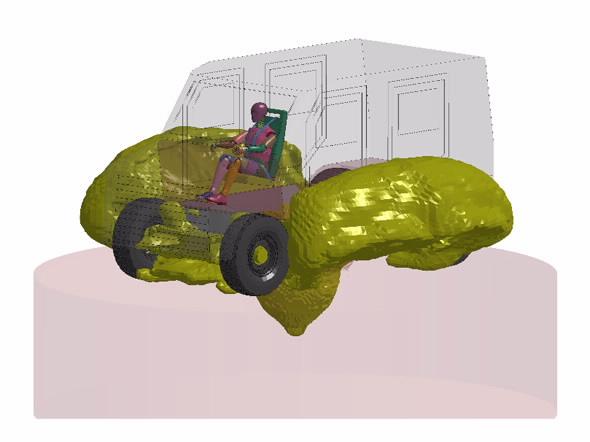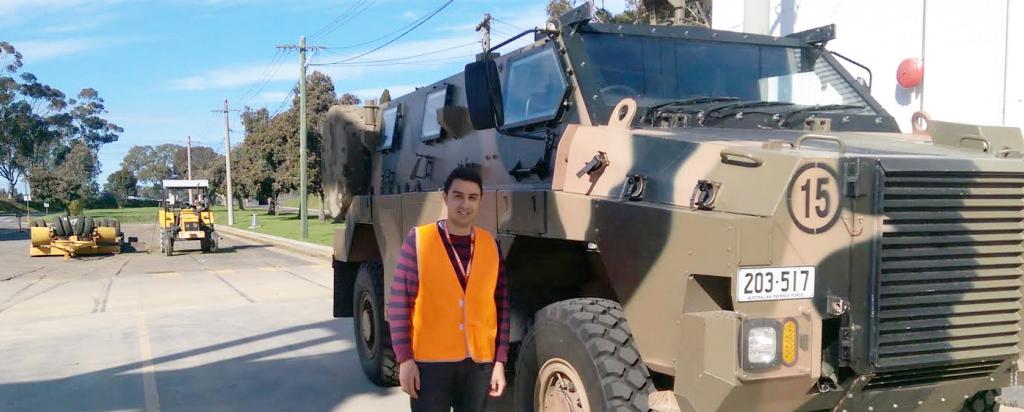

Published on the 26th September 2017 by ANSTO Staff
“This partnership reflects a co-investment in research and development activities that strengthen Australia’s defence priorities on ambitious but attainable projects,” said Paul Di Pietro, Head of Innovation and Integration, ANSTO.
The Department of Industry & Innovation identified multidisciplinary materials science as a priority need for the development of next generation technologies using materials and processes that support advanced manufacturing.
ANSTO provides access to a range of complementary techniques for multi-disciplinary materials to make technological advances to reduce detection of Australian Defence Force platforms and improve ballistic and shock protection.
Traditional materials characterisation methods can be enhanced by techniques that are available using ANSTO’s neutron beam instruments at the OPAL reactor, synchrotron X-ray and infrared beamlines at the Australian Synchrotron, advanced microscopy, imaging and computer modelling.
“We have had considerable success on a range of projects collaborating with the defence industry, DST and university partners,” said Di Pietro.
ANSTO’s key capabilities were used in past work with DMTC that focused on the design characterisation and manufacture of ultrahigh temperature materials and the development of predictive simulations of both product manufacturing and performance.
Powerful computer modelling capabilities have been used to simulate ballistic and blast modelling of armour for both land and marine defence platforms.
ANSTO’s work has delivered innovative solutions for the production of high performance materials and systems for use in both supersonic rocket and hypersonic scram jet propulsions systems. ANSTO has collaborated on the development of advanced sensors and hypersonic materials to support Australia’s defence and national security objectives.
Advanced modeling to support vehicle design
There have been many and varied contributions at ANSTO to support defence science over the past ten years, which culminated in 2013 Eureka Prize for Outstanding Science in Safeguarding Australia.
The award was shared by DSTG, Thales Australia, armour manufacturers Bluescope Steel, the University of Wollongong and Swinburne University of Technology for development and commercialisation of high-performance armour materials and manufacturing techniques which are increasing the levels of protection and performance offered by military land vehicles and to operating personnel.

Powerful computational models developed at ANSTO helped to solve complex structural, fluid and physics problems in a virtual environment.
Modelling can contribute to determining the vulnerability of platforms, such as how components react to the high strain rate deformation from a blast and assists in establishing lifetime assessments. Models are validated against experimental results.
A current DST project in association with Thales and the University of Melbourne extends advanced modelling to developing systems level simulation capability for the design and service life evaluation of military land vehicles.
Aviation and aerospace research
Research at the Australian Synchrotron helped deliver optimal performance and longevity for gas turbine engines used in aerospace applications. Synchrotron X-ray powder diffraction was used to study how dust particles ingested during take-off or landing react with the thermal barrier coating on jet engines when operated at high temperatures.
These investigations found that densification of the zirconia components of the coating following reaction with dust particles reduced the thermal barrier coating’s ability to thermally insulate the engine and protect it from failure.
The Kowari neutron strain scanning instrument at the OPAL reactor provided measurements that supported an investigation of residual stresses that were generated by laser cladding and laser additive manufacturing, commonly used in aircraft repair. It allowed the investigation of residual stress through various stages of the technological process, to pinpoint the most effective enhancement procedure.
ANSTO has assisted with assessments of processes for producing ultra-high temperature ceramics that improve the efficiency of jet engines. In other research, investigations have led to
improvements in the production of titanium alloy materials for aerospace applications.
Assessing repair technologies
DSTG researchers have made use of the Kowari strain scanning instrument at the OPAL reactor to evaluate repair techniques and technologies, such as the viability of automated gas tungsten arc welding for components made with titanium alloys.
Using neutron diffraction techniques on the Kowari strain scanning instrument, the residual stresses of several components were quantified non-destructively. This research allowed the influence of various weld processing parameters to be examined, enabling the optimisation of residual stresses within the final components.
Another DST project, in association with the French shipbuilding group DCNS (Naval Group) and the University of Wollongong is a scoping study of low distortion welding processes, specifically for a critical T-joint component used in virtually all naval shipbuilding.
Next-generation acoustic system transducers for submarines
Materials researchers at ANSTO, in partnership with Thales, are contributing to improvements in the production of single crystal piezoelectric ceramics for the next generation of underwater acoustic systems transducers for submarines.
Protecting National Security
ANSTO has a broader mandate in nuclear stewardship and nuclear forensics for Australia that contributes to nuclear security, non-proliferation and combating nuclear terrorism.
Collaborations between ANSTO and DST have included building a robot with a radiological sensor payload aboard to allow remote detection of potential radiological threats.
“It is a watershed moment for defence industry and innovation in Australia, and ANSTO very much looks forward to making further contributions to next generation technologies for Australia’s defence and national security,” said Di Pietro
As a founding core participant in the Defence Materials Technology Centre (DMTC), ANSTO supports the Australian Defence Force and Australian Defence Industry by providing access to scientific research infrastructure and expertise in materials engineering and advanced manufacturing.
“This partnership reflects a co-investment in research and development activities that strengthen Australia’s defence priorities on ambitious but attainable projects,” said Paul Di Pietro, Head of Innovation and Integration, ANSTO.
The Department of Industry & Innovation identified multidisciplinary materials science as a priority need for the development of next generation technologies using materials and processes that support advanced manufacturing.
ANSTO provides access to a range of complementary techniques for multi-disciplinary materials to make technological advances to reduce detection of Australian Defence Force platforms and improve ballistic and shock protection.
Traditional materials characterisation methods can be enhanced by techniques that are available using ANSTO’s neutron beam instruments at the OPAL reactor, synchrotron X-ray and infrared beamlines at the Australian Synchrotron, advanced microscopy, imaging and computer modelling.
“We have had considerable success on a range of projects collaborating with the defence industry, DST and university partners,” said Di Pietro.
ANSTO’s key capabilities were used in past work with DMTC that focused on the design characterisation and manufacture of ultrahigh temperature materials and the development of predictive simulations of both product manufacturing and performance.
Powerful computer modelling capabilities have been used to simulate ballistic and blast modelling of armour for both land and marine defence platforms.
ANSTO’s work has delivered innovative solutions for the production of high performance materials and systems for use in both supersonic rocket and hypersonic scram jet propulsions systems. ANSTO has collaborated on the development of advanced sensors and hypersonic materials to support Australia’s defence and national security objectives.